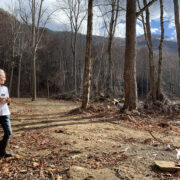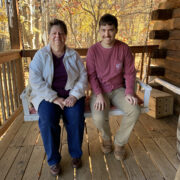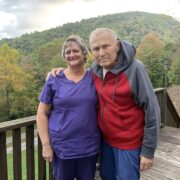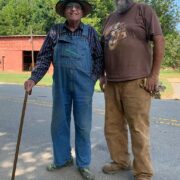Need help health insurance through the ACA? Counselors will be on hand to answer your questions, including: 1. Can I be denied certain benefits because of preexisting conditions? 2. Will my current health issues affect insurance rates? 3. How much do insurance plans cost? 4. What do insurance plans cover?
A tiny lady with sturdy boots and a neat grey bun walks between high heaps of gnarled and tangled debris. Identifiable items poke out at odd angles: an axle with wheels here, an auger bit there. A hula hoop. Now and then the breeze carries a whiff of rot.
The Pigeon River slips by, just a stone’s toss away.
There’s a sense of sadness and confidence about her – a good-natured person who’s having a rough time. Bending down, she captures a windblown leaf, studies it, and remembers a nursery rhyme.
“A wise old owl lived in an oak,” she recites, pointing with her leaf. “The more he saw, the less he spoke. The less he spoke, the more he heard. Now, wasn’t he a wise old bird?”
Sherrie McArthur hasn’t heard too much lately, but she’s waiting.
Her 51-year-old family business in Cruso, Laurel Bank Campground, was utterly destroyed in August during floods wrought by the remnants of Tropical Storm Fred. Some guests died, others were traumatized, and her campground is unrecognizable.
Like many hardy residents of the valley, she’s buckled down and done her best. She hasn’t asked for much, and she’s accepted with grace the help that came her way. But now she’s grappling with the fact that she just doesn’t know what’s next.
The campground won’t reopen, at least in anything like its current form. “You can’t sow grass on rocks,” says McArthur, “the water washed away all the dirt.”
Not to mention that if the river came up that high once, it is likely to do it again. Massive erosion on the back side of the property during the flood exposed smooth river stone – a sign that the river once flowed there and might return – and heavy storms are becoming more commonplace.
Sherrie’s living space, a tidy A-frame, survived, but just barely. Volunteers are helping her make it livable again.
Other volunteers have bulldozed the broad, deep fields of rubbish into high mounds. But what does she do with it now? She doesn’t know who to ask, or really what the ask might be. Like many of her neighbors, she’s not used to being a squeaky wheel.
“People tell me to ‘be patient,’” she says. “They say the government moves slowly, but it moves. I guess in the meantime I’ll just keep living right here in the middle of it.”
Sherrie has always been an innkeeper of sorts. She’s spent her entire life, year after year, welcoming guests to a place that represents happiness for them.
When she and her brother Doug were little, before the business opened, the land was their family farm and they’d pitch a tent by the river to camp. It gave their father, Harold Crawford, an idea. Shovel in hand, day-by-day, he built the campground.
Soon she and her brother were campground kids, being teased at school for smelling like woodsmoke, and eventually she’d raise her own sons there.
“It’s always been the sweetest place,” she says. “It was kind of magical. When I opened each May, guests would be hugging each other like they were home. They’d be hugging my neck.”
Sherrie feels the weight of responsibility and loss. Many of the 95 campsites were held by seasonal campers with an average age of 70 or so. Most of them lost everything.
On the day of the flood, Sherrie had an inkling. No warnings were posted, but the rain pounded down and things didn’t feel right.
She talked to Cruso Fire Chief Tim Henson, who was hopeful that things wouldn’t worsen, but who urged caution.“I trusted my gut,” says Sherrie, who knew her guests would be hard to motivate on a mere hunch.
“I decided ‘I’m gonna tell a little white lie and say officials told us to move to higher ground,’” she says, and she began ushering campers to a pavilion, which was the agreed upon high water “safe spot.”
As it turned out, there was barely time. A violent landslide across the valley showed that things were getting worse fast. A pounding deluge high up the valley had come after two days of hard rain, and the river level rose abruptly.
“It was too much,” says Sherrie, “That was the angriest water I’ve ever seen in my life. Nobody had seen the river like that, even the old, old, old people.”
One camper tried to flee the campground in her car, despite warnings, and was swept away. Another died when he stepped out of his truck into waist-deep water and was caught in the current.
Most campers had gathered at the pavilion, but soon it was clear that it wasn’t high enough. Two at a time, Sherrie moved guests along a fenceline that climbed the hill behind, holding the hog wire as they pulled themselves to safety. Gathered at Sherrie’s son’s house up the hill, stunned and silent, they waited for the water to recede.
Almost three months later, Sherrie walks along at the upper end of the property.
A few hundred yards across the tranquil river, a man slowly creeps the shoreline with a backhoe. He lost a load of steel beams to the flood when his trailer washed away, and he’s searching the riverbed to find them – one piece at a time.
“It’s affected everybody in Cruso,” says Sherrie. “We all got walloped.”
“I thought I was prepared after Ivan,” she says, “but this was way more than a 100-year flood.” Hurricane Ivan, in 2004, caused serious, but not catastrophic damage to the campground, and she’d made some infrastructure changes since. Also, she was insured then, but insurance covered very little of the damage. This year she wasn’t insured, and said that she couldn’t have afforded it even if she’d found a willing underwriter.
As she strolls back home, she points out a destroyed building – the camp laundry – and the remains of an ice machine. Hospitality folks know the value of those machines, they are expensive and much-valued.
“I thought I’d bought the last ice machine I’d ever need,” Sherrie says, “and evidently it was. I just didn’t need it for as long as I expected to.”
Opening the door to her house, she sees that volunteer carpenters from Baptists on Mission have been by. They’re helping with the replacement of damaged cabinets and flooring.
“Look at this,” Sherrie says, stepping into her kitchen, “I got a new threshold!”
“They’ve taken care of me and so many in this little community,” she adds. “We’re all astonished, amazed and grateful and humbled. It’s wonderful work. Quality work. We can’t thank them enough.”
“Believe me, I say my thank you prayers,” she says, “and I need to say more.”
___
Flood disaster recovery efforts continue to unfold, with recent news of 20 million dollars in state funds allocated to rebuild or elevate homes in the Pigeon River Valley. Rapid Rehousing efforts, managed by Baptists on Mission Disaster Relief Ministry and funded by contributors to Mountain Projects and United Way of Haywood County, will enable assistance to nearly 50 homeowners. A generous $500,000 donation by the Dogwood Health Trust will help up to 28 additional homeowners, for a total of more than 75 homeowners assisted by the initiative.
If you know someone who owns their home and needs Rapid Rehousing assistance, or if you’d like to volunteer to help with ongoing housing rehabilitations, please contact Bill Martin at 336-408-8393.
If you’d like to contribute to ongoing emergency needs and relief efforts, please call or email Mountain Projects Executive Director, Patsy Davis, at (828) 492-4124 or [email protected].
“We expect the recovery from this flood to take several years,” said Davis
When Brenda Stroupe remembers her own experience of Haywood County’s catastrophic flood of August, 2021, she thinks about the Christian lessons of 2 Corinthians.
“The Bible says you know a man by his spirit, not by his flesh,” Stroupe says, as she recalls a community that rallied to support its flood victims. But from there she goes on to tell a compelling story of both spirit and flesh – a harrowing tale from Hidden Valley Circle, one of the county’s hardest-hit neighborhoods.
Brenda and her husband Robert “Red” Stroupe, then a Canton police officer, bought their handsome two-story log home in 2013 at the lower end of a pretty, leafy neighborhood near Bethel. Red passed away in 2016, and Brenda now lives there with their son, Lee, 23.
The house is in the bottoms, near the east fork of the Pigeon River, and it’s damp there, she says, and wet when it’s rainy, but with their house perched on a high foundation flooding was never a huge worry. As rain pelted down for the third straight day on August 17, however, she had a sense of foreboding. She’d had a nightmare two nights prior that involved flood water – and even included the word “tsunami” – and it kept coming to mind.
She and Lee were keeping an eye on the river, but hadn’t yet seen reason to worry when another son, Jerry, working in Cashiers, saw an alert that the Pigeon was rising, and called to urge them to higher ground.
Brenda balked, and Jerry called her hard-headed. “Y’all need to pack a bag!” he urged, and eventually Brenda agreed. But even as she and Lee were upstairs throwing a few clothes together, the river arrived. In a matter of seconds water swirled around both sides of the house.
Lee isn’t a swimmer, and Brenda was recovering from recent surgery, so they were at a standstill.
In the distance neighbors were hustling around, rescuing what they could, and one waded deep to pull the Stroupe’s camper to safety. Several offered to try to help them through the swirling brown current, but Brenda and Lee decided to risk it in their sturdy house. Remembering the thick flow, she says “I’ll never look at chocolate pudding the same way again.”
Lee ran to the basement to pull the main breaker and ran back up, and moments later they heard a strange sound. The eight-foot basement had abruptly filled with water, and floating appliances were banging against the ceiling.
“Son, let’s pray, or we’re doomed,” Brenda said. “We started praying and I said Lord if you don’t send an angel we’re gonna be gone.”
They got another phone connection to Jerry and his sister Joy, who were desperate for them to escape to higher ground. “Son, you don’t understand!” Brenda recalls saying, “there’s nowhere to go!” Everyone was terrified. They all had the sense they were saying goodbye. “I’ve never had fear grip me like that in my life,” Brenda said.
Outside the water roared.
Somehow, during the chaos, Brenda looked out the front window and noticed that a tall shepherd’s crook plant hanger in the front yard was nearly submerged, with only a few inches above water. But when she glanced again, more of the crook was visible. Soon there was yet more above water.
“It happened so quick, and then it started going back down, just as quick,” Brenda said.
Still, the neighborhood was torn apart. Two houses had been floated off their foundations, with one nowhere to be seen. Several more were flooded or destroyed. One man and his son were perched in a tree, waiting for help.
Eventually boats came and helped the Stroupes away.
Brenda spent the following days trying not to let her emotions overwhelm her. They stayed with Joy and her family in Canton. “It was still fresh and I’d wake up with nightmares,” she said. One night she startled everyone by shouting in her sleep “the water’s in here! The water’s in here!”
“It’s like a death,” Brenda said. “One day you handle it fine and the next day you can’t.”
The day after the flood was bright and clear, and the Stroupes visited their house.They’d lost one dog, but a second survived, and their cat showed up for breakfast, rattled but ready. Their neighbor’s bull, who Brenda sometimes hand fed – but who she’d doubted survived – showed up to greet them.
They started to sense they’d be ok.
Hidden Valley Circle was a sight to behold. Since the neighborhood was at the bottom end of the valley it was easy to reach, and an army of help had arrived.
“It was awesome,” said Brenda.
Many churches were represented, along with people from all around the community. “Do y’all need help?” was the question of the day. One man pumped the water out of the Stroupe’s basement, and a bucket line formed to muck out the mud. Another showed up with a tractor on a trailer, and when Brenda suggested they had so much help he might should seek out another neighborhood, he said “no ma’am, this is the place I’m supposed to be.”
Houses were surrounded by volunteers, carrying furniture, brandishing shovels and doing the painful early labor of recovery.
“God was using these people – their hands and feet – to do his work,” said Brenda. Before long, Bill Martin arrived. A representative of Baptists on Mission Disaster Relief Ministry, Bill has helped many Haywood County residents since the flood, and here he was at Brenda’s door.
Their home wasn’t as badly damaged as some others, but the damage was still severe, with systems ruined and water soaking into the floor on the main level.
“I don’t have the family or the means to do this on my own,” she told him. “I don’t have any insurance. I don’t have the money to pay for anything.”
Martin told her not to worry. “We’re here to help you get back in your home,” he said. “You are blessing us by letting us do it.”
Brenda’s impulse was to resist, which is a dynamic Martin has seen many times among independent-minded Haywood County community members. But he reassured her, and she eventually said yes. “Sometimes you have to learn to get rid of the pride and let God help,” she said. “Sometimes you do more harm than good by not accepting.”
Since then, Martin and his team of volunteers have been a steady presence for the Stroupes.
“It’s been amazing what they’ve done,” said Brenda, who said they’ve involved and taught Lee during their work, helping him grasp skills he would’ve learned from his father. “Personally, I long ago forgot how to shut up,” she says with a laugh, “but Bill’s always willing to listen. It’s like having a big brother or an uncle giving you advice.”
At the end of each work day, when family and volunteers gather for a prayer, Brenda gives thanks. “[God] laid it on other people’s hearts to help us,” Brenda said. “He’s used people that are willing to help.”
Rapid Re-Housing projects are supported by the expertise of Baptists on Mission disaster relief volunteers and with financial contributions made to Mountain Projects and the United Way of Haywood County.
The Stroupe’s home is one of almost 50 houses in process of Rapid Rehabilitation since the flood.
If you know someone who owns their home and needs Rapid Rehousing assistance, or if you’d like to volunteer to help with ongoing housing rehabilitations, please contact Bill Martin at 336-408-8393.
If you’d like to contribute to ongoing emergency needs and relief efforts, please call or email Mountain Projects Executive Director, Patsy Davis, at (828) 492-4124 or [email protected].
“We expect the recovery from this flood to take several years,” said Davis.
A little over a year ago Victor de Mancia and his wife Crystal moved to Cruso from Wisconsin, mostly because they were charmed by the beauty of the mountains, but also because they felt oppressed by weather. They were sick of Wisconsin snow.
On August 17 they got a flood instead. Record-breaking levels of water roared down the valley at Cruso, brought on by heavy and prolonged rains high on Cold Mountain. The de Mancia’s home was nearly destroyed, and their property strewn with vehicles, outbuildings and all manner of assorted debris.
What came next, though, was what they consider a flood of blessings. In two short months they’ve experienced extraordinary kindness, shared some of their own, and reached an enormous personal milestone all at once.
“It was a total catastrophe,” Crystal says, “but it brought people to us that will be forever friends – people we never would’ve met otherwise. And right in the middle of it all Victor was called for his immigration exam.”
Victor came to the United States from El Salvador 20 years ago, and he and Crystal, a native Minnesotan, have been married for 12. Just as they tackled this flood recovery – with their heads swirling from all there was to do – they made an unexpected trip to Charlotte, where Victor took the test, passed, and became an American citizen.
—
The de Mancias fell in love with the mountains a couple of years ago on vacation and decided to work out the details for a move south. Eventually they found their house in Cruso: a sturdy mid century rancher with blonde brickwork, a nice yard, a pavilion for picnics, and the river nearby.
Crystal and Victor spent the first six months working on the property and home, making it their own. They looked forward to settling in and sharing it with friends. Crystal took a job at Haywood County Animal Services and Victor, a mechanic and handyman, took work in apartment complex maintenance.
They were both at work when the river came up. Unable to reach home, they spent the night on the floor of Victor’s work office in Canton, terrified for their house and pets: four birds, two dogs and a cat.
They had reason to be concerned: when the Pigeon left its banks along their stretch of the river, water crashed into the garage end of their house and swirled down an open stairwell into the basement. When the basement was full, the water burst through a wall at the far end of the house and continued on its way.
The de Mancias made their way home the next day to find their pets rattled but safe and their house a mess. The basement was an awful quagmire, and two walls – one on each end of the house – were badly damaged.
At first, their home was “red-tagged” by the county as a total loss, but they were able to find an engineer, Preston Gregg, of Waynesville, to complete an assessment and cost breakdown so that they could obtain a restoration permit and stay put.
“We’ve been blessed to remain home when so many neighbors were displaced,” Crystal said. “And we were also blessed to have so much help.”
A local couple, Pam and Craig Carter, came by way of New Covenant Church. They were on the scene almost immediately and organized volunteers to help both the de Mancias and their neighbors begin the cleanup.
After the downstairs had been laboriously mucked out, more volunteers from Baptists on Mission Disaster Ministry and Samaritan’s Purse helped remove the ruined furnace and ductwork, power washed the basement, and treated the space for mold. Even more help came from members of the de Mancia’s church, Barberville Baptist, and from old Minnesota friends Doug and Susan Mueller, now in Asheville, who contributed a heat pump and rallied more help from their neighbors.
Victor had the skills to pitch in with the neighbors’ houses as well as his. Among other things he’s a dowser, and he used his talent to help find the wellhead of the elderly couple next door, buried under a few feet of silt.
The couple’s challenges didn’t end within the walls of their home. Because their property is in a particular section of the Pigeon, with level woodland lying inside the curve of the river, it collected an extraordinary amount of flood-borne debris – along with a deceased victim.
Emergency personnel searched their land for days afterward, and when they were gone, the debris remained, including a Toyota pickup wrapped around a tree by the force of the water, outbuildings at odd angles, a recreational vehicle, and countless smaller pieces of furniture, appliances and rubbish. The couple was a bit mystified about what they were supposed to do with all the junk.
But Baptists on Mission came to the rescue once again, helping clear debris with bobcats so that county contractors could haul it away.
There’s still plenty of work to do, and while Haywood County Animal Services held Crystal’s job, Victor was let go when he couldn’t return immediately to work. He’ll soon be looking again.
Still, the de Mancia’s have been amazed by how their new community pulled together in the face of crisis.
“What was also wonderful is that nobody was asking if you were left or right, blue or red, or what color your skin was,” Crystal said. “Instead they asked us what our needs were and how they could help meet them. It was absolutely wonderful.”
—
There’s still a lot of work to accomplish to get Haywood residents back on their feet. More than 65 individuals continue to live in the shelter. 114 homes were completely destroyed and more than 700 homes were damaged by flooding.
Well before the floods, our community was facing an affordable housing shortage. Since August 17th, the issue has become mission critical. Through a partnership between Baptists on Mission, the United Way and Mountain Projects, funds have been raised to support more rehab for 52 homes.
Currently, there are seven rapid house rehabilitation jobs that are complete, 26 more that are in process and 16 initial participants that opted for other solutions. If you know a homeowner affected by flooding that needs home rehabilitation, or can refer skilled tradesmen to assist with this work, please contact Bill Martin of Baptist on Mission, 336-408-8393.
This is the story of Toma and Clara Pop, who came together in Haywood County, nearly lost each other, and found extraordinary grace in their community afterwards.
When the Pop’s Mundy Field home was swept off its foundation in the catastrophic flood of August 17, Toma, 73, went with it. He swam free at the last second and lashed himself to a tree, where he was battered and scraped by floating debris until help came. Clara, 57, waited in a panic at a roadblock near Frank’s Grocery in Bethel, where she’d been stopped by emergency personnel.
Desperately trying phone calls, she finally reached her aunt, Ruby Lee Rhodes, whose house was up the hill behind theirs. Rhodes asked “Are you all ok? Where are you? Where’s Toma?”
“He’s at the house,” Clara said.
“Clara,” Rhodes said, “your house is gone! It’s all to pieces!”
Two months later it’s a beautiful October day on Cove Creek and the Pops are telling their story. They’re housed for the moment in a relative’s home not far from the Cataloochee Divide and a very long way from the nearest flood plain. They’ve lost nearly everything they owned.
Married for seven years, this is the second marriage for both of them. Clara’s family has been in Cruso for generations, while Toma, an immigrant who fled Ceaușescu’s Romania on foot 40 years ago, is a proud first generation citizen, a mechanic who built an American life from scratch. Their lives converged when she worked in Haywood County’s medical community and he was a patient.
Clara
When Clara left work at Haywood Surgical Associates on the day of this story, there was already talk about heavy rain and flood risk. A meeting had been cancelled. Still, she had no real reason to worry, and she checked in with Toma by phone and stopped for a loaf of bread. A half-hour later she crested the hill just past Bethel and pulled up short at the roadblock. She could go no further.
“Once you get to the packing house,” a fireman told her of a familiar Cruso landmark, “there’s nowhere else to go.”
She was stunned. The packing house was just before their house. Both are a pretty good way from the river, and the bottoms at Mundy Field, beneath Sugar Top mountain and Poison Cove Top mountain, are broader than upstream. Still, Clara’s family had always said that the river once ran on their side of the valley and that if enough rain came, it could do it again. She’d never been sure she believed it.
“I have to get to my house, my husband is in there. He isn’t well!” she said, and the fireman began working the radio in the chaos, learning what he could.
Frantically she called hospitals. No luck at Haywood. No luck at Mission. Then short messages began trickling in by radio. They thought he’d been rescued, one message said, another said he’s been rescued, but we don’t know where he is.
At last, hours after she arrived at the roadblock, a call got through from another neighbor, Denver Blalock. “We have Toma,” he said.
Toma
Toma Pop’s big dog Chase was strangely nervous that evening, barking to come inside. He wasn’t allowed in much, plus the weather was rainy and the house was clean. But Toma relented and brought him indoors, just before his brief check-in with Clara.
Not long after he hung up, there was a tremendous roar. The house shuddered and floor tiles popped into the air as the floor flexed.
Mystified, Toma opened the french doors that led to the couple’s mud room. The mud room was gone. And at that moment water rushed in, rising quickly to his chest. Afraid of being caught inside as water rose toward the ceiling and with thoughts he might crawl onto the roof, he plunged out the door into the torrent. He went under, saw light above, came up, and grabbed hold of something – the gutter at the eave of the house.
The house floated free from its foundation and twisted in the current as he held tight.
“Usually we don’t have trees around our house,” said Toma, “and I looked up and now our house was in the trees.”
He grabbed hold of one of those trees, and with his other hand he took off his belt, wrapped it around a branch, and lashed his wrist tight. There he hung, water to his neck, one arm raised over his head.
He doesn’t know how long he waited – he says it felt like an hour. Eventually he heard neighbors shouting for him as they searched, he called back, and before long members of a Jackson County rescue squad team arrived in a boat. They threw him a life jacket and eventually wrestled him on board.
He was safe.
Neighbors later described a 10-foot wall of water, tumbling down the valley.
Afterwards
It’s been a difficult couple of months for the Pops. A scattering of things were recovered: Toma’s mud-caked guns, some keys, and a few other odds and ends. But most of their belongings are gone and Chase the dog was never seen again. The couple contracted Covid in the aftermath, and while Clara recovered quickly, it’s been harder for Toma, who’s having trouble getting around.
Then there’s the trauma. “Every night when I go to bed, I hear the sounds in my head and taste the water in my mouth,” said Toma.
And Clara lost her family home.
“I’ve lived there all my life. I was raised there,” she said. “My mama worked hard to pay for that house. All those memories were there – it’s hard. I go up the river and all the people I grew up with, their houses are gone.”
“Here I am 57 years old and I’m going to have to start all over again,” Clara said. “I know there’s people more affected than I am, but it’s still really hard. At least I still have my husband.”
The Silver Lining
It’s hard to make sense of such sudden, catastrophic events. The silver lining for the Pops has been the enormous generosity of friends, neighbors, and many total strangers.
“From the moment of the flood on, the generosity of the American took over,” says Toma, lowering his forehead to his hands. “Even now, people ask me if we’re comfortable enough. We have clothes! We have a roof over our heads! What more could we want?”
The community gave them clothing, food, a place to stay – whatever they needed, and a constant stream of support. Riverside Baptist. Co-workers at Haywood Surgical Associates. Many, many more.
“There’s no doubt in my mind that Haywood County people are the most wonderful people in the world,” said Clara. “I’ve never felt as loved. You think no one loves you, and then something like this happens.”
Toma nodded.
“What affected us most wasn’t the event,” he said. “A flood is a flood. These things happen. What affected us was what came after.”
Holding both hands in front of his chest and pinching his thumbs to his fingers, Toma shook his head and the tears came.
“Many people who had very little to give, gave us whatever they had,” he said. “In a lifetime I couldn’t return this generosity.”
_________
The Haywood County Rapid Re-Housing drive has raised money for more than 40 houses so far, with more in the pipeline. The original goal of 10 houses has been raised to 50 after a strong local response. The total number of houses in need isn’t yet known.
If you’d like to contribute to rapid-rehousing efforts in Haywood County, we urge you to make a donation to the United Way of Haywood County, 81 Elmwood Way, Suite 140 or PO Box 1139, Waynesville, NC 28786.
If you’d like to learn more about rapid rehousing, please call or email Mountain Projects Executive Director, Patsy Davis, at (828) 492-4124 or [email protected]. Mountain Projects is also accepting donations for a general flood recovery fund.
“We expect the recovery from this flood to take several years,” said Davis.
In the days before the flood came Steve Henson, 57, was in the hospital, undergoing infusion treatment for a serious case of Covid.
But Tuesday the 17th he was home, exhausted, short of breath, and with every intention of a long rest.
Little did he know.
The Henson family lives on property at the upper end of Old Michael Road where US 276 makes a pass over the East Fork of the Pigeon River.
“We’ve lived here our whole lives,” says Steve. “We’re used to high water.”
Even so, that days’ mid-afternoon rain was heavy enough that Steve thought precautions were wise. He climbed into his truck and drove a few hundred yards down to his workshop, situated on the bank of the river, and moved his dump truck to slightly higher ground. Then he headed back home.
In the short three minutes it took him to reach his house, floodwater swept through the valley bottom below and crashed into the family home owned by his father Roy, 86. Steve had no idea. But the phone was ringing, and it was his sister, who’d gotten a call from their dad, who said he was wet up to his knees and didn’t know why.
“Water’s coming in everywhere,” he’d told her.
Steve rushed back down the drive, but was stopped short by a deep flow where just minutes before there’d been a roadway. He was at a standstill, and looking out across the valley through the rain he spotted his dump truck. “It was swimming in circles like a duck,” he said.
His father’s house was 200 feet away, across a chest-deep current. There was no question of wading. “My oxygen levels were really low. If I’d waded and fainted, I’d have been gone.”
At that point, he said, everything felt dreamlike.
Roy waited in the house, which luckily was situated somewhat long ways to the flow. That bought time, but a Cadillac SUV, floating along at a good clip, crashed through french doors into a converted garage, letting more water in. Inside the house it rose, reaching six inches at the highest level of the structure.
But that’s where it stopped rising. The water had come like a rushing wall, but in this part of the valley there’s a bit more room and the torrent spread out.
A neighbor soon arrived to help Steve across, and they snagged a passing Igloo cooler and used it to move Roy to safety.
The flood didn’t drain away as quickly as it arrived, but it did drain away, and then there was damage all around. A second Cadillac rested in the yard. Steve’s Harley-Davidson, parked at his dad’s house, was buried under a crush of debris. The neighboring commercial farmland, with hundreds of tomato plants, lay flat. Inside was a mess. But the next day help arrived.
“We’ve had people from day one,” said Steve. “We’ve been so blessed – we’ve had more help than we could’ve imagined.”
Volunteers, friends and neighbors set about saving cabinets, cutting out walls and pulling up floors. They fed the family for days. Among them were members of Pinnacle Church in Canton and coordinators for Baptists on Mission Disaster Relief Ministry, a veteran disaster relief organization with experience helping hurricane victims and many others.
Mountain Projects and United Way of Haywood County have created a Rapid Re-Housing Challenge to gather funds, and Baptists on Mission are coordinating efforts to make flood-damaged homes safe, sanitary and livable through basic repairs. They do the work at cost, which is an average of $17,500 per house.
Roy’s family home, built in 1966, became one of the organization’s Haywood County projects, and volunteers from First Baptist Church of Four Oaks among other churches, began work.
Like many in Cruso, Steve and Roy say this flood was worse than the floods of 2004, when remnants of two hurricanes pummeled the watershed. They’re concerned that fallen trees – especially hemlocks dying from blight – are clogging waterways and increasing flood danger.
“None of that is being maintained,” Steve said. “They’ve fallen like matchsticks up through there, and when the water comes up they get caught against bridges and culverts. The water has to go somewhere.”
Their primary concern, though, is with their neighbors, many of whom were uninsured or couldn’t get flood insurance.
”Some won’t be able to rebuild,” Steve said. “A lot would’ve been better off if their house had burnt to the ground.”
_______
The Haywood County Rapid Re-Housing drive has raised money for more than 40 houses so far, with more in the pipeline. The original goal of 10 houses has been raised to 50 after a strong local response. The total number of houses in need isn’t yet known.
If you’d like to contribute to rapid-rehousing efforts in Haywood County, we urge you to make a donation to the United Way of Haywood County, 81 Elmwood Way, Suite 140 or PO Box 1139, Waynesville, NC 28786.
If you’d like to learn more about rapid rehousing, please call or email Mountain Projects Executive Director, Patsy Davis, at (828) 492-4124 or [email protected]. Mountain Projects is also accepting donations for a general flood recovery fund.
“We expect the recovery from this flood to take several years,” said Davis.
ADVERTISEMENT FOR BIDS
Proposed Site Improvements for Harris Estates
Mountain Projects, Inc. – Owner (Smoky Mountain Housing Partnership)
Sylva, North Carolina
Sealed bids will be received by Mountain Projects, Inc. at their office located at the 2177 Asheville Road, Waynesville, NC 28786 for the construction of the Proposed Site Improvements for Harris Estates in Sylva, North Carolina until 2:00 pm EST on Wednesday, September 22, 2021, at which time they will be opened and read aloud. The bidder shall show evidence of qualifications by clearly displaying his or her current license number on the outside of the sealed envelope in which the proposal is delivered.
The project is located on a 1.2 acre ± tract of undeveloped land at the end of Second Avenue in Sylva, North Carolina. The project will include site improvements needed to prepare the site for five new single family homes which will be built by others. The project work will include excavation, earth filling, grading, storm drainage, erosion control, asphalt paving, approximately 840 LF of 2” HDPE water main and related incidental work.
Bid Documents may be obtained by qualified bidders from the issuing office of Lofquist & Associates, Inc., 11 Citrus Drive, Sylva, North Carolina 28779, (828) 586-1424. Qualified bidders may obtain digital copies of bid documents at no cost and/or printed copies of bid documents are available for a non-refundable cost of $150.00 per set from the issuing office.
Bid proposals shall be submitted by qualified contractors and must be accompanied by a bid security in an amount of 5 percent of the bidder’s maximum bid price.
The owner reserves the right to reject any or all bid proposals.
Mountain Projects, Inc.
CHARLOTTE, N.C. – The Board of Directors of Canopy Realtor® Association and Canopy MLS, unanimously voted August 26 to donate $200,000 each, for a total of $400,000 in funds to support Haywood County flood relief efforts.
2021 Canopy Realtor® Association/Canopy MLS President David Kennedy said “We care deeply about the people and communities that we serve and now more than ever our neighbors who have lost their homes and so much more need our assistance.”
Kennedy adds that hearing from our local leadership and Realtor® members in the Western Region as to the amount of devastation this community has undergone is not only heart wrenching but a call to assist.
Seventy-five percent, amounting to $300,000 in funding, will be allocated to the United Way of Haywood County, and the remaining 25 percent, amounting to $100,000, will be donated to Mountain Projects, for a grand total of $400,000.
Brian Cagle, a Canopy MLS and Canopy Foundation Board of Directors member and Vice President/Managing Broker of Beverly-Hanks & Associates, said, “I am simply overcome and filled with gratitude for the overwhelming support from our industry.”
Canopy Realtor® Association is headquartered in Charlotte and is the professional trade association that provides Realtors® in Mecklenburg, Iredell and Haywood counties with resources and services to conduct ethical, professional and profitable businesses. Haywood Board of Realtors® became part of Canopy Realtor® Association on January 1, 2020, establishing the Western Region.
Canopy MLS is a wholly-owned subsidiary corporation of Canopy Realtor® Association and is the private broker cooperative used by Realtors® to bring buyers and sellers together with access to thousands of residential listings in a multi-county service area, including Charlotte, the mountains area of North Carolina, South Carolina, and beyond.










